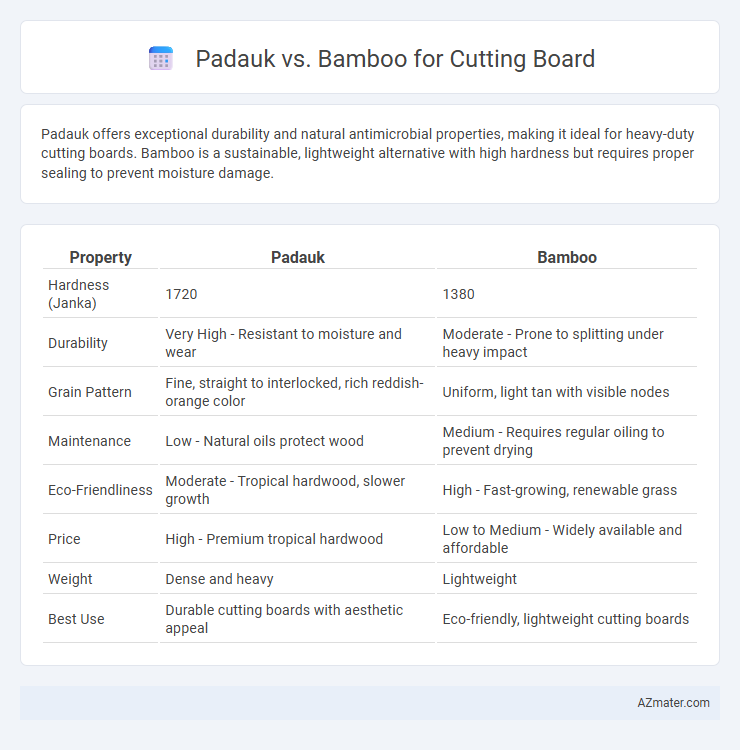Padauk offers exceptional durability and natural antimicrobial properties, making it ideal for heavy-duty cutting boards. Bamboo is a sustainable, lightweight alternative with high hardness but requires proper sealing to prevent moisture damage.
Table of Comparison
| Property | Padauk | Bamboo |
|---|---|---|
| Hardness (Janka) | 1720 | 1380 |
| Durability | Very High - Resistant to moisture and wear | Moderate - Prone to splitting under heavy impact |
| Grain Pattern | Fine, straight to interlocked, rich reddish-orange color | Uniform, light tan with visible nodes |
| Maintenance | Low - Natural oils protect wood | Medium - Requires regular oiling to prevent drying |
| Eco-Friendliness | Moderate - Tropical hardwood, slower growth | High - Fast-growing, renewable grass |
| Price | High - Premium tropical hardwood | Low to Medium - Widely available and affordable |
| Weight | Dense and heavy | Lightweight |
| Best Use | Durable cutting boards with aesthetic appeal | Eco-friendly, lightweight cutting boards |
Introduction to Padauk and Bamboo Cutting Boards
Padauk cutting boards are crafted from dense hardwood known for its durability, natural resistance to moisture, and vibrant reddish-orange hue, making it both functional and visually appealing. Bamboo cutting boards are produced from fast-growing grass, offering an eco-friendly option with a hard surface that resists knife scarring and bacterial growth. Both materials provide unique benefits for kitchen use, balancing aesthetics, sustainability, and performance.
Key Characteristics of Padauk Wood
Padauk wood is valued for its rich reddish-orange hue, exceptional hardness, and resistance to decay, making it ideal for durable cutting boards. Its dense grain structure enhances knife retention and minimizes scoring over time, providing a long-lasting surface for food preparation. Unlike bamboo, Padauk offers a more traditional hardwood feel with natural antibacterial properties, contributing to safer kitchen use.
Key Characteristics of Bamboo Material
Bamboo cutting boards are prized for their natural hardness, resistance to knife marks, and eco-friendly sustainability due to rapid growth cycles. Their dense, fibrous structure resists moisture absorption, reducing the risk of warping and bacterial growth. Additionally, bamboo's lightweight nature and smooth surface make it an ideal material for durable, easy-to-maintain kitchen tools.
Durability Comparison: Padauk vs Bamboo
Padauk exhibits superior durability compared to bamboo due to its dense hardwood structure, making it highly resistant to knife marks and warping. Bamboo, while eco-friendly and renewable, tends to be softer and more prone to scratches and water damage over time. For long-lasting cutting boards, Padauk's hardness and natural oils provide better durability and resistance against wear.
Maintenance and Care Requirements
Padauk cutting boards require regular oiling with mineral oil to prevent drying and cracking, as the dense hardwood is prone to absorbing moisture and developing surface checks without proper care. Bamboo cutting boards demand less frequent oiling due to their natural hardness and antimicrobial properties but benefit from occasional conditioning with food-safe oils to maintain their durability and prevent splintering. Both materials should be hand-washed promptly and dried thoroughly to avoid warping, with Padauk needing more vigilant maintenance to preserve its rich color and structural integrity over time.
Knife Friendliness and Surface Hardness
Padauk cutting boards exhibit higher surface hardness, typically measuring around 1,730 on the Janka scale, which means they resist dents and scratches effectively but can be tougher on knife edges. Bamboo offers a slightly softer surface with a Janka hardness of approximately 1,380, providing better knife friendliness by reducing blade dulling over time. Choosing between Padauk and Bamboo hinges on balancing durability and preserving sharpness, with Bamboo favored for maintaining knives and Padauk for long-lasting, sturdy cutting surfaces.
Sustainability and Environmental Impact
Padauk wood, sourced from tropical hardwood trees primarily in Africa and Southeast Asia, is valued for its durability and vibrant color but faces challenges due to slower growth rates and habitat loss, raising sustainability concerns when harvested unsustainably. Bamboo, a fast-growing grass native to Asia, is highly renewable and requires minimal pesticides or fertilizers, making it one of the most eco-friendly materials for cutting boards with a smaller carbon footprint and rapid replenishment. Choosing bamboo cutting boards contributes to reduced deforestation and promotes sustainable material use, whereas Padauk's environmental impact heavily depends on responsible forestry practices and certification.
Aesthetic Differences: Color and Grain
Padauk cutting boards feature a rich, vibrant reddish-orange hue that deepens over time, offering a bold and luxurious aesthetic. Bamboo cutting boards display a lighter, pale yellow to tan color with a uniform, fine grain that creates a clean, modern look. The pronounced grain patterns in Padauk provide a striking, natural contrast, while Bamboo's subtle, linear grain imparts a sleek and minimalist visual appeal.
Price and Availability
Padauk cutting boards typically cost more due to the wood's exotic nature and limited supply compared to bamboo, which is widely available and more affordable. Bamboo boards are abundant as bamboo grows quickly and is harvested sustainably, making them a budget-friendly and eco-conscious choice. Padauk's rarity results in higher prices and less consistent availability in the market.
Which Cutting Board Is Best for You?
Padauk cutting boards offer exceptional hardness and rich reddish hues, making them highly durable and visually striking, ideal for heavy-duty chopping. Bamboo boards provide a lightweight, eco-friendly option with natural antibacterial properties and excellent resistance to moisture, suitable for everyday kitchen use. Choose Padauk for long-lasting wear and aesthetic appeal, while Bamboo suits sustainable, low-maintenance cooking needs.

Infographic: Padauk vs Bamboo for Cutting Board
 azmater.com
azmater.com